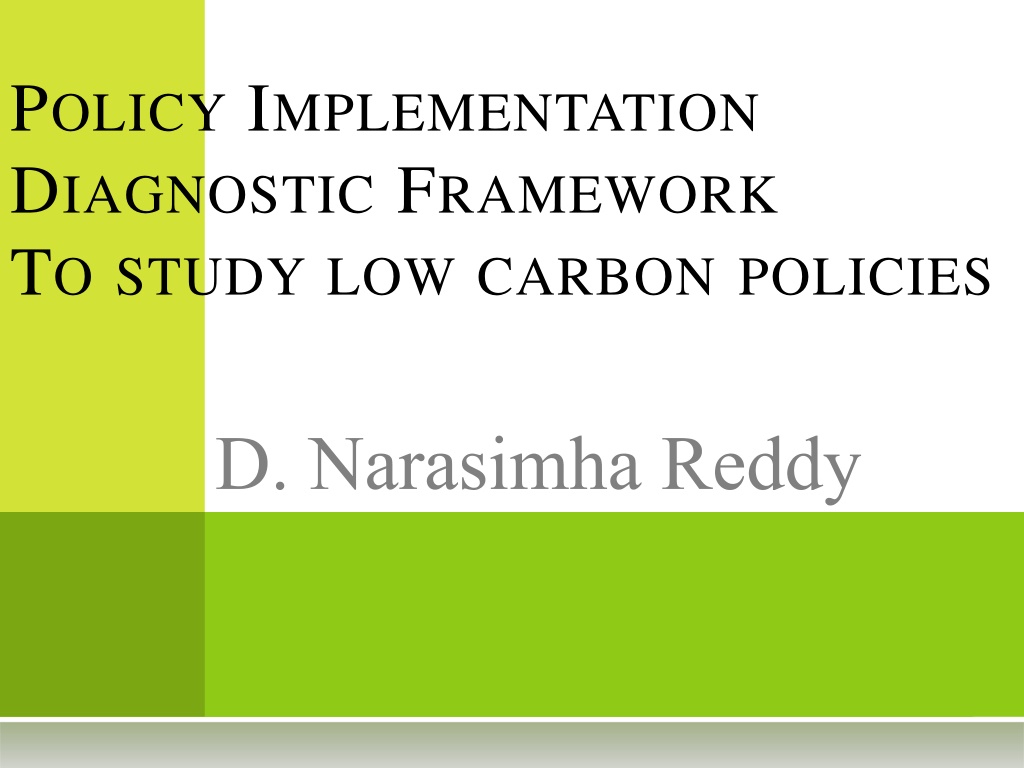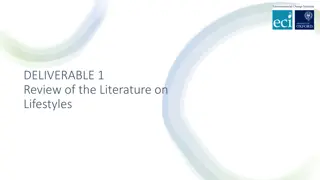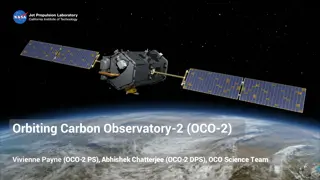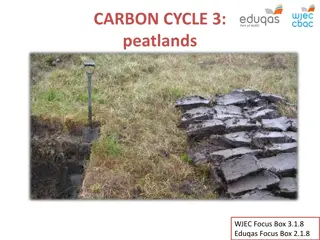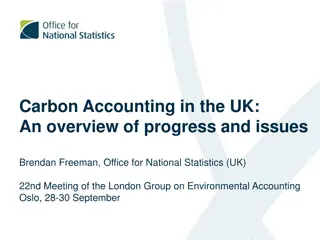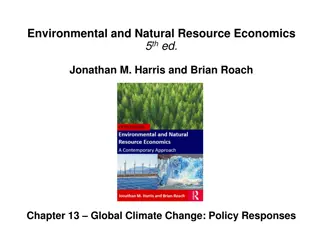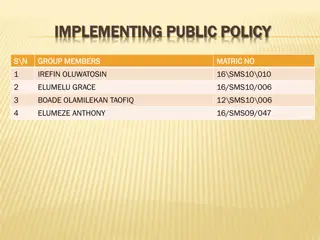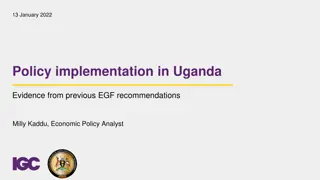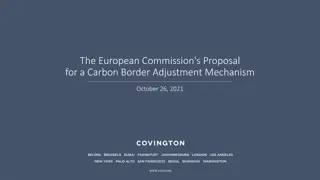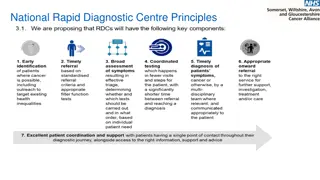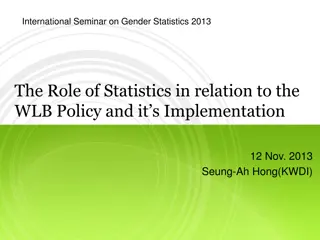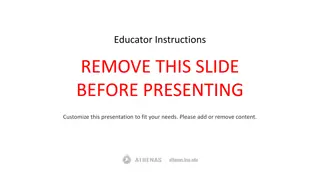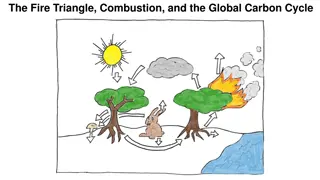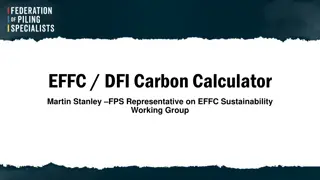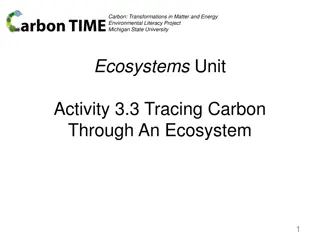Understanding Policy Implementation Diagnostic Framework for Low Carbon Policies
Explore the Policy Implementation Diagnostic Framework designed to analyze institutional factors and enhance the effectiveness of low carbon policies. Discover the importance of addressing implementation deficits, creating enabling environments, and identifying practices for successful policy implementation. Learn about key objectives, stages, functions, and aspects such as administration and finance within this framework.
Download Presentation

Please find below an Image/Link to download the presentation.
The content on the website is provided AS IS for your information and personal use only. It may not be sold, licensed, or shared on other websites without obtaining consent from the author. Download presentation by click this link. If you encounter any issues during the download, it is possible that the publisher has removed the file from their server.
E N D
Presentation Transcript
POLICY IMPLEMENTATION DIAGNOSTIC FRAMEWORK TO STUDY LOW CARBON POLICIES
POLICY IMPLEMENTATION DIAGNOSTIC FRAMEWORK: HELPS To institutional factors support in-depth assessment of A detailed involved in policy implementation analysis of the institutions Identify ways to strengthen implementation process and enhance policy effectiveness
WHY IMPLEMENTATION DIAGNOSTIC FRAMEWORK? Design and execution of the policy implementation process is important Putting policy in place not sufficient Implementation deficit a barrier to policy effectiveness Create enabling environment
WHY IMPLEMENTATION DIAGNOSTIC FRAMEWORK? Enhanced capacities to manage complex systems a new set of human resource capacities Need for a coherent set of governance and institutional arrangements Institutional mechanisms to avoid capture of regulatory process
OBJECTIVES Determine the extent to which key institutions have the mandate and resources to implement the policy Determine the extent to which policy implementation adheres to policy design Identify barriers to effective policy implementation Identify practices that facilitate successful policy implementation
STAGES Policy as written Policy in practice Policy implementation is not linear process
FOUR KEY FUNCTIONS Administration Monitoring, reporting and revision Finance Compliance and enforcement
ADMINISTRATION Institutions or teams (within the Institutions) responsible Steps need to be taken to start and maintain the programme
FINANCE Adequacy of financial and other resources Effective fund management systems How those resources /funds are used? Extent of funding
COMPLIANCE AND ENFORCEMENT Provision for compliance Ways in which compliance is promoted penalties and incentives Mechanisms for ensuring compliance
MONITORING, REPORTING AND REVISION Essential for understanding the policy s effectiveness and correcting errors if any Helps to improve coordination among institutions System for monitoring implementation and effect of the policy
FIVE PRINCIPLES OF GOOD GOVERNANCE Roles and responsibility Institutional capacity Coordination Stakeholder engagement Transparency
ROLES AND RESPONSIBILITY Institutions/actors responsible for implementation Whether specific roles and responsibilities are clearly defined Whether there are specific rules that govern these roles and responsibilities
INSTITUTIONAL CAPACITY Skill and capacity of the project staff to manage resources, address technical issues and ensure compliance Attributes of institutional capacity include: Human and financial resources Level of skills and training Interest in policy issue Leadership of an institution
COORDINATION Implementation involves actions by multiple agencies/groups Coordination in the form of information sharing, resource sharing and joint action Extent to which goals of agencies align Clear lines of communication among agencies responsible for implementation
STAKEHOLDER ENGAGEMENT Diverse and meaningful input from a range of actors helps improve policy formulation and implementation Identify areas where engagement is needed Formal space for participation Mechanisms to invite participation Inclusiveness and openness of processes Extent to which the gathered input is taken in to account
TRANSPARENCY Stakeholder engagement need to go hand in hand with transparency so that stakeholders have access to information Ease of access to information Comprehensiveness Timeliness Efforts to reach out to affected and vulnerable
EXAMINING POLICY ADMINISTRATION - 1 Administration Role and responsibility Identify relevant functions Identify relevant institutions Whether the institution exists Whether necessary steps are taken or what are the steps taken? Whether steps taken are consistent with policy
EXAMINING POLICY ADMINISTRATION 2 Administration Institutional capacity Capacity of identified institutions? Capacity addition efforts
EXAMINING POLICY ADMINISTRATION 3 Administration Coordination Do the functions require coordination among institutions? What coordination is required? What mechanisms have been designed for coordination? (Like committees) Whether the mechanism succeeded in coordination. Whether each institution point of view taken in to account Whether coordination led to delays
EXAMINING POLICY ADMINISTRATION 4 Administration Stakeholder engagement What are the provisions for stakeholder engagement To what extent provisions have been carried out
EXAMINING POLICY ADMINISTRATION 5 Administration Transparency What documents are relevant? What are the provisions for transparency? To what extent documents are publicly available? Are relevant documents easy to access by range of stakeholders?
FINANCE To identify those responsible for mobilising and spending funds Rules and regulations that govern spending Whether institutions involved have the technical knowledge and capacity to manage the funds Scope and relevance of stakeholder engagement in financial management Transparency in financial management
COMPLIANCE & ENFORCEMENT Agencies responsible for enforcing compliance Whether there are rules governing compliance and enforcement Whether the concerned institutions have human resources to enforce compliance Extent of stakeholder engagement in enforcing compliance Disclosure of process and reports of compliance
MONITORING Agency responsible for monitoring policy administration Whether systems in place for monitoring, reporting and revision Whether institutions have the capacity to monitor and report Provisions for and extent of stakeholder participation in monitoring policy administration Transparency: access to monitoring and evaluation reports
SETTING THE INSTITUTIONAL CONTEXT Overarching questions about national provisions National Climate Action Plan or Low Carbon Development Plan Institutional mandates for implementation Overarching laws related to transparency, stakeholder participation, and monitoring and evaluation Political support for the policy
CUSTOMISATION OF DIAGNOSTIC FRAMEWORK The framework is intended to be applicable across States, or countries Researchers to take decisions about how best to use the framework depending on the specific context
